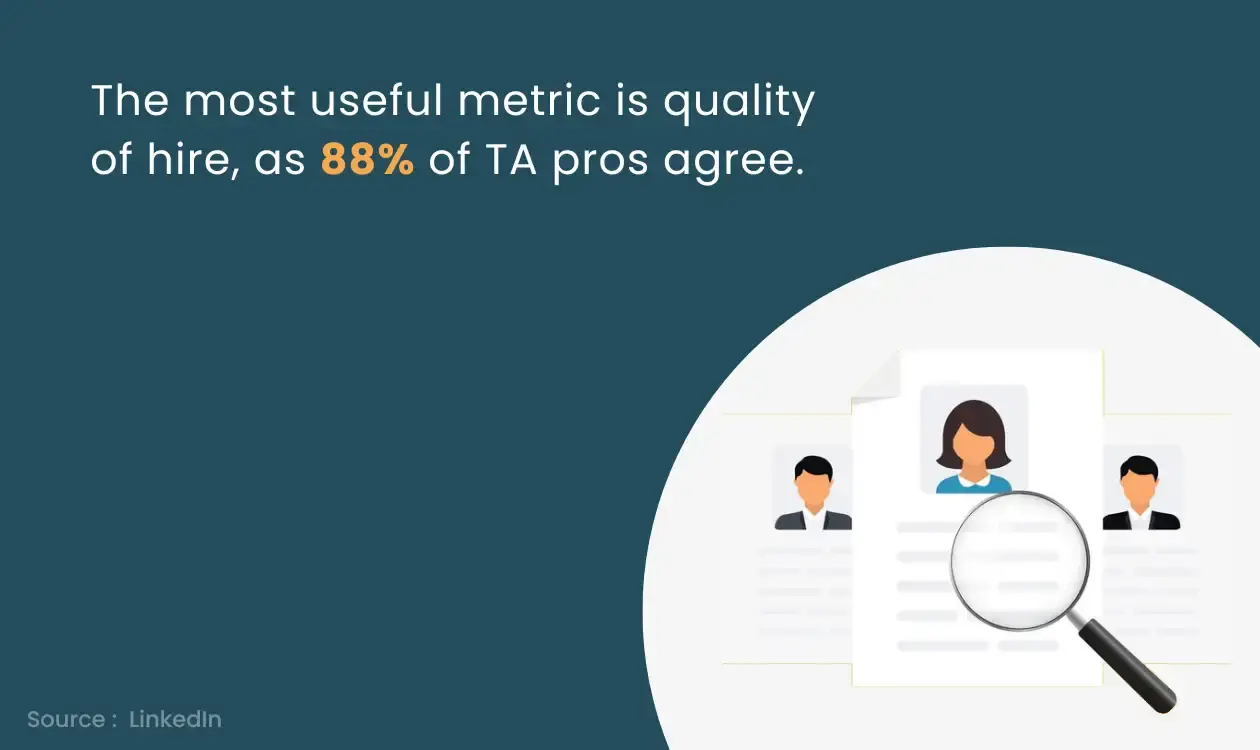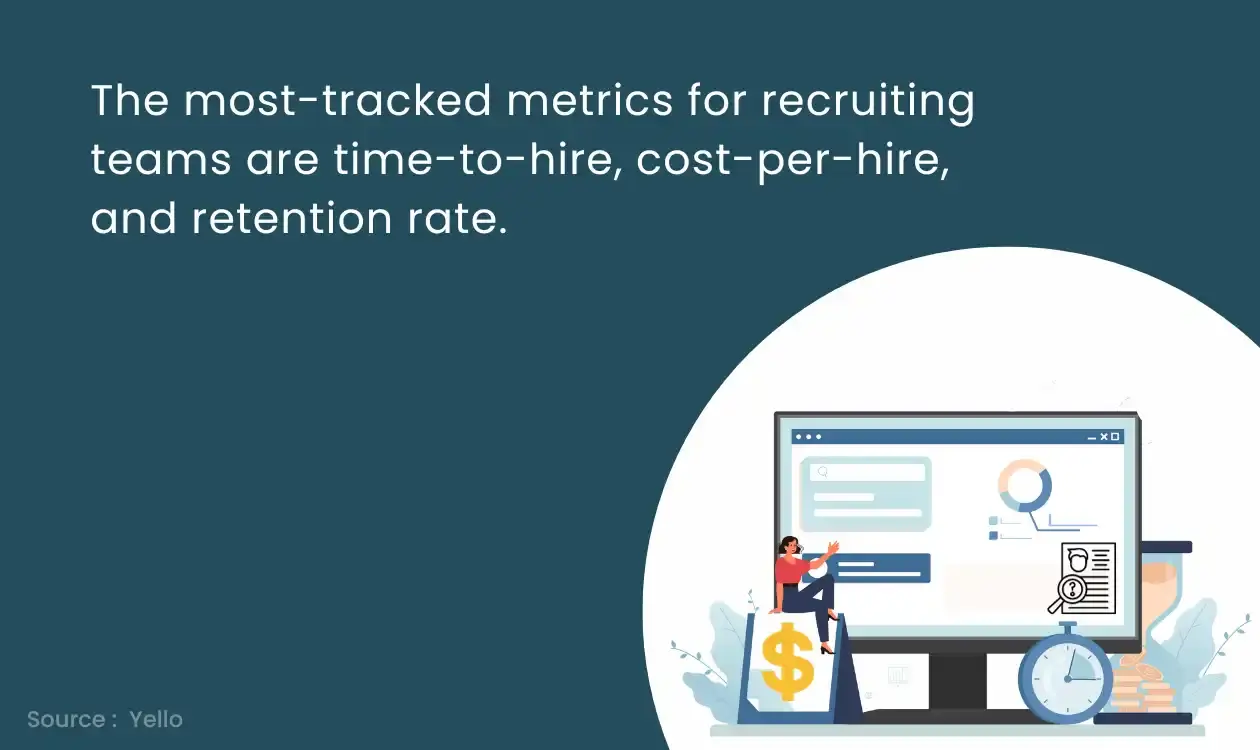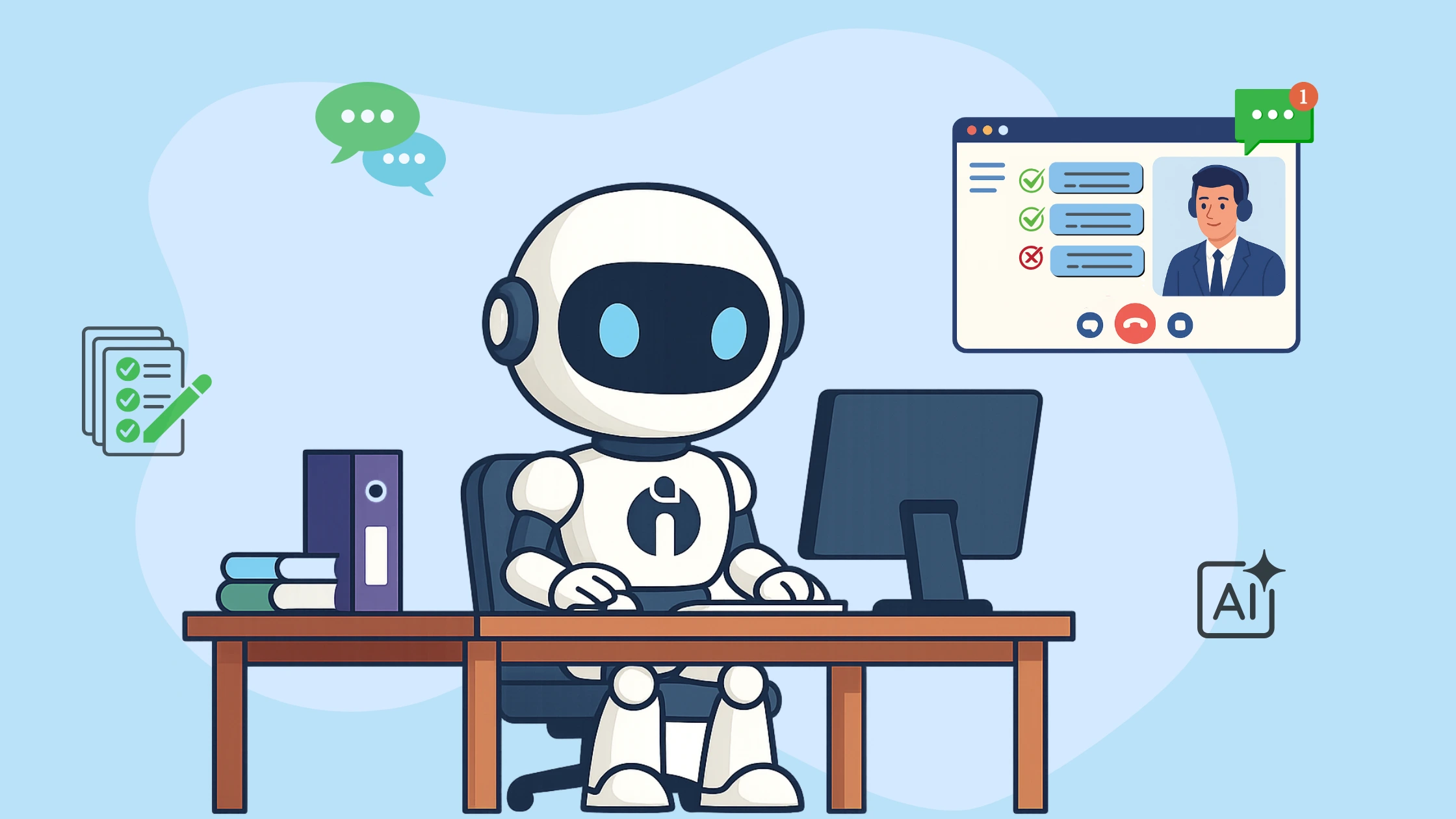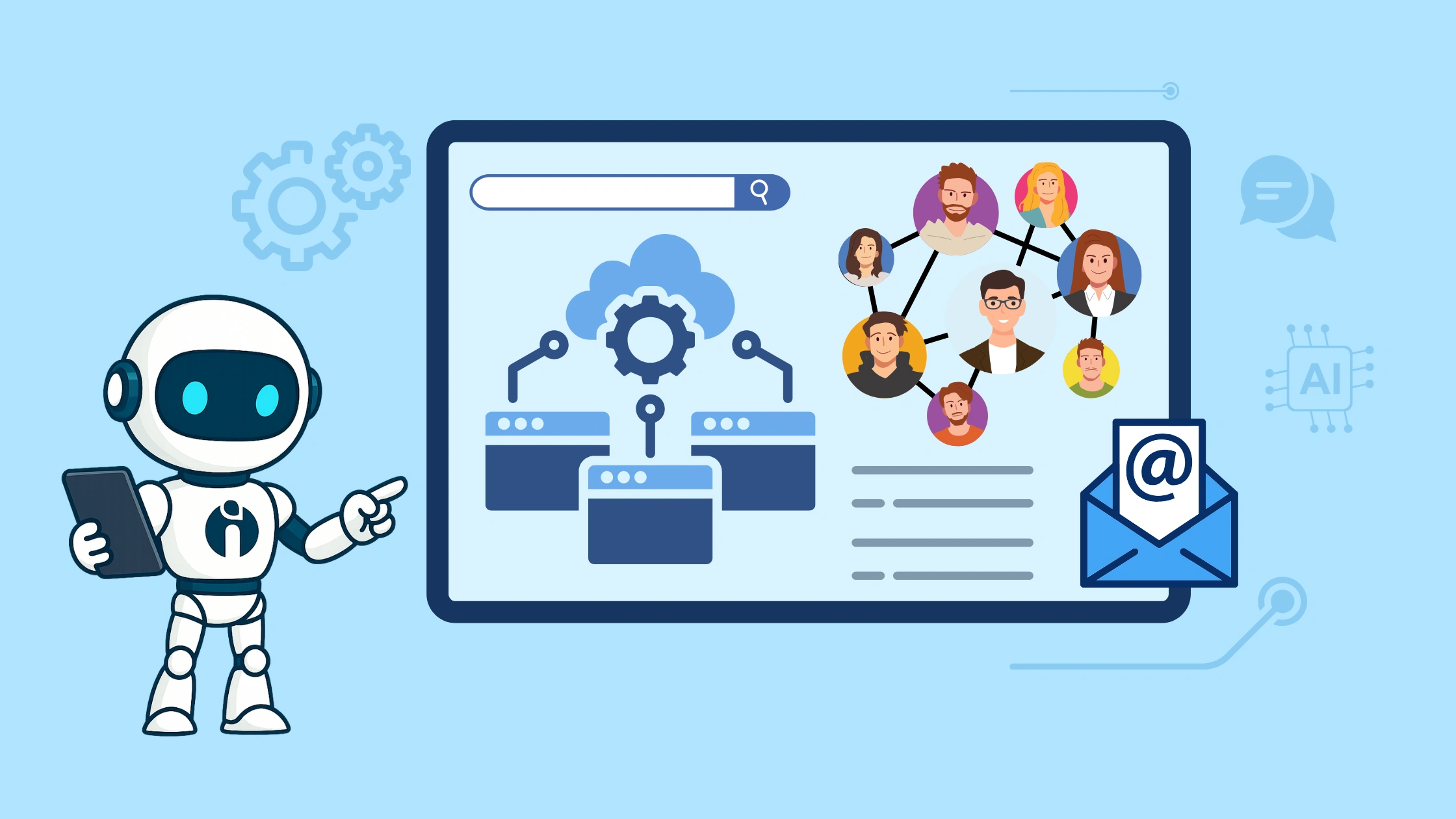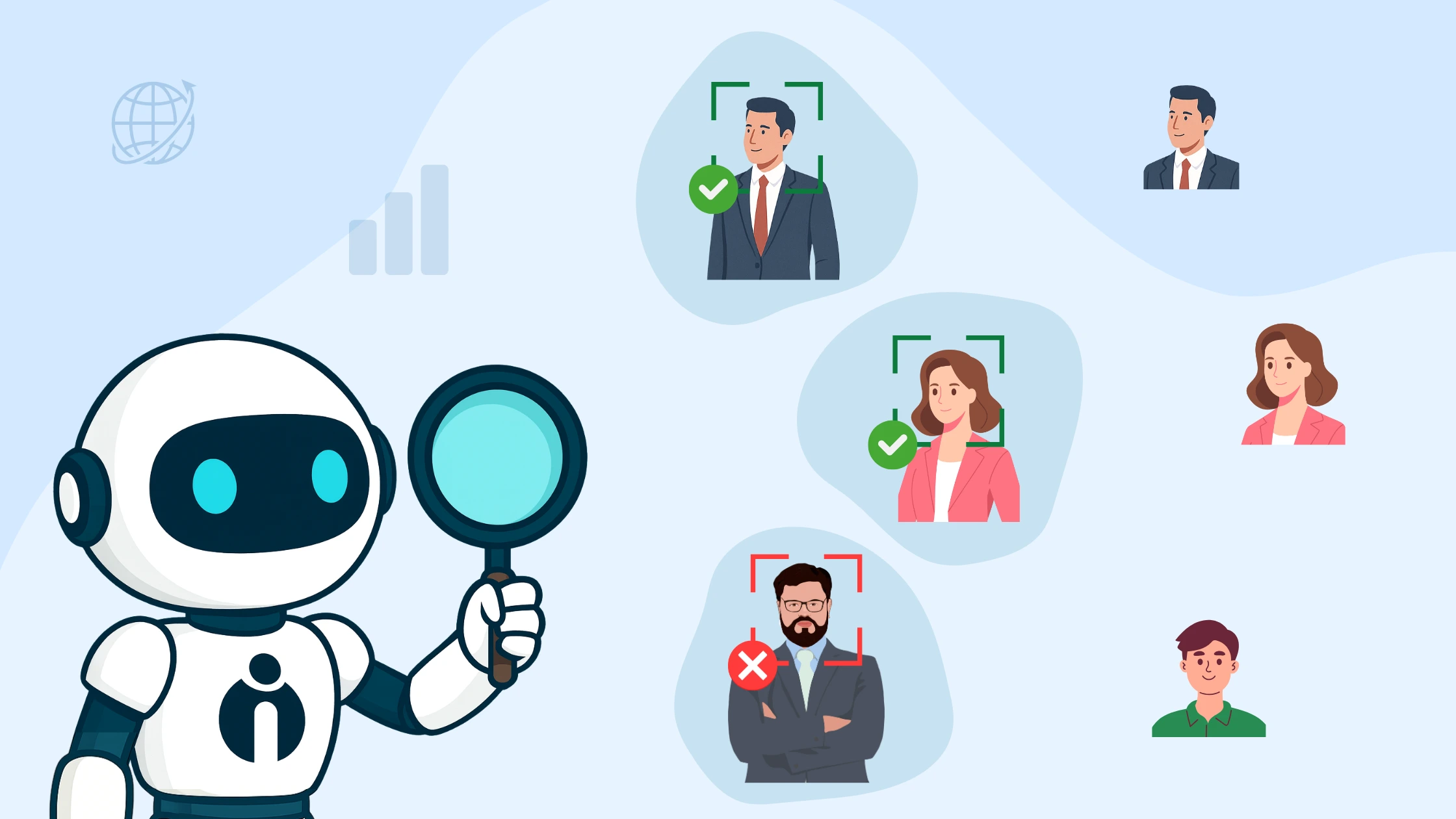TL;DR
- Recruitment analytics uses data to enhance hiring efficiency and quality by identifying key metrics and trends.
- Top benefits include hiring quality candidates, improving decision-making, increasing efficiency, and enhancing candidate experience.
- Important metrics to track are time to hire, cost per hire, quality of hire, sourcing channel efficiency, and retention rate.
- Recruitment analytics progresses through operational reporting, advanced reporting, and predictive analytics stages.
- Common challenges include data integration issues, resistance to change, privacy concerns, tech barriers, and data accuracy.
- Best practices recommend setting clear goals, collecting quality data, using suitable analytics software, and acknowledging data limitations.
- iSmartRecruit provides an AI-powered ATS platform offering customised dashboards, advanced reporting, automated and compliant recruitment analytics.
The recruitment landscape is ever-growing, and the phrase “Data is power” becomes true and more relevant to stay competitive in the hiring market.
Those traditional recruitment days are over when hiring decisions are made just based on human intuition.
Modern-day recruiters and HRs harness the power of data-driven information to make informed decisions that align with their organisation’s long-term goals, reduce hiring costs, and improve the quality of hires.
According to LinkedIn, recruiting professionals believe analysing data to make hiring decisions will become an indispensable part of recruitment over the next five years.
So, are you looking for ways to create the best recruitment strategies? Do you want to find out the inefficiencies and bottlenecks of your recruitment workflow? No worries because we have a solution in just one word to all of your questions. The word is “Recruitment Analytics.” But wait, how?
Let’s dive together into this guide to leverage the revolutionary potential of hiring analytics and why it is important.
What is Recruitment Analytics?
Recruitment analytics is real-time data you collect and organise during the hiring process to understand its efficiency and find potential loopholes. In the recruitment industry, recruitment analytics is also known as hiring analytics, recruitment channel analytics, and talent acquisition analytics. The names are different, but they all mean the same thing.
Hiring managers, HRs, and recruiters to track, manage, and analyse all the metrics relating to your hiring process. It is also called talent acquisition metrics.
Basically, it is about identifying and understanding meaningful patterns for candidate sourcing, selecting, and hiring. Recruitment analytics helps hiring teams calculate their recruitment efforts and improve their strategy purely based on hard-core data, not just instinct.
Before we move further, let’s understand why hiring analytics is crucial for recruitment professionals.
Why does Recruitment Analytics Matter in 2026?
Before understanding the vitality of recruitment metrics, we have to look into the more fundamental question: Why has data-driven recruitment become the talk of the town recently?
The answer is way too simple! Data-backed decisions are taken based on past evidence of what has worked and what should be avoided. This way, recruiters identify the traits of successful recruitment and enhance the efficiency of the process.
So, data is imperative, and to use it effectively, you need recruitment analytics, which lets you observe the hiring data in the simplest manner. A survey done by LinkedIn found that hiring teams with mature recruitment analytics are 2x more likely to improve their recruiting efforts.
By using recruiting analytics in the right way, recruiters and HR can make informed decisions, boost efficiency, streamline hiring workflow, stay ahead in the competitive talent market, and anticipate future hiring needs and trends.
Let’s explore in detail the key benefits talent acquisition professionals will get from recruitment analytics.
Top 6 Benefits of Recruitment Analytics
Analysing and tracking the analytics in recruitment offers numerous fruitful benefits. Here are some of the key advantages of hiring analytics.
1. Hire Quality Candidates Only
Recruitment analytics helps you identify the most effective channels for attracting top talent.
So, you can invest more in sources by tracking where your best hires come from (job boards, social media, employee referrals).
It also shows which parts of your job descriptions and interview process resonate with strong candidates.
Also, recruitment analytics help identify which keywords in the job description attract the right candidates. This allows you to tailor your recruitment strategy to attract individuals who are a great fit for the role and your company culture.
2. Precision in Decision-Making
Hiring managers can make informed and data-backed hiring decisions. It provides a wealth of metrics like time-to-hire, cost-per-hire, and offer acceptance rates.
Analysing this analytics data helps you identify bottlenecks in your hiring process and areas for improvement.
Imagine having data to show which interview questions are the best predictors of success in a particular role. This would be more accurate as it would not be based on gut feeling but on evidence-based insights.
3. Gain Higher Recruitment Efficiency
Recruitment analytics can streamline your hiring process by highlighting inefficiencies and bottlenecks.
For example, you might discover that a particular stage in your hiring process takes an unusually long time. By analysing the data, you can identify the cause of the delay and take steps to address it.
Then, you can use AI recruitment software to automate those manual tasks, which will ultimately increase recruitment efficiency.
4. Provide Positive Candidate Experience
Candidates form an impression of your company based on their experience during the recruitment process.
It can help you identify areas where the candidate's experience can be improved.
For instance, you might see a high drop-off rate at a particular stage in your application process.
By investigating the reasons behind that, you can identify and remove any unnecessary hurdles that could discourage qualified candidates.
5. Achieve Higher Retention Rates
Hiring the right person from the start is crucial for reducing turnover. Recruitment analytics can help you assess the effectiveness of your onboarding process.
It also helps you understand the factors that contribute to employee turnover, such as poor job fit or lack of career development opportunities.
By addressing these issues, you can improve your employee retention rates and reduce the costs associated with turnover.
6. Craft Targeted Recruitment Strategies
Recruitment analytics makes you smarter with your recruitment approach by eliminating guesswork. It helps you to gain a deeper understanding of your ideal candidate profile.
By analysing data on your top performers, you can identify the skills, experience, and qualifications that are most successful in your company.
This information can then be used to create targeted job descriptions, interview questions, and recruitment campaigns.
The more targeted your recruitment strategy, the better your chances of attracting the perfect fit for your open positions.
Most Important Metrics in Recruitment Analytics
Do you want to shift from a mediocre hiring process to an outstanding one?
Then, you need to track and analyse crucial hiring and recruitment metrics, which are as follows.
1. Time to hire
Time to Hire = The day they accept the job - the day the recruiter reaches the candidate
Hiring time is a frequently utilised metric by hiring and HR managers to assess the required time to hire the most suitable talent. They calculate the time it takes from when a recruiter opens a job opening until a candidate accepts the job offer. The time-to-hire metric is crucial to assess the overall recruitment efficiency.
2. Cost per Hire
Cost Per Hire = Internal recruiting costs + external recruiting costs / total number of hires
Recruiters will get the total amount spent to fill an open position, which includes job advertising, recruitment software subscription charges, recruiter fees, and staff time. Keeping this number in check ensures that the recruitment process is cost-effective.
3. Quality of Hire
Do you want to measure the first-year performance of new hires? Do you want to review their progression and their impact on the team? Then, this recruitment metric will give insight into how well the recruitment process is identifying top talent.
The LinkedIn survey found that 40% of companies believe that the quality of hire metric is their top priority.
The metric can be efficiently calculated by dividing it into two parts.
-
Pre-hire quality
-
Post-hire quality
Pre-hire quality = No. of managers who are very satisfied with a talent pool / total number of surveys filled out
Pre-hire quality metric measures the quality of the pre-screening part, with the aim of attracting the candidates who are most likely to thrive in the open role.
Post-hire Quality = No. of workers who leave within a year of hire date / total No. of workers who leave during the same period
Whereas the post-hire quality metric reviews the quality of new hires and their contribution to the organisation’s progress.
4. Sourcing Channel Efficiency
Sourcing Channel Efficiency = total number of hires via the channel / total number of applications via channel x 100
Identifying the best sourcing channel to hire talented candidates for a particular open role is way too tough and time-consuming. But, with this recruitment metric, recruiters can know exactly which channel delivers the best candidates for a specific position.
5. Applicant-to-Hire Ratio
Applicant to Hire = Total number of applications / Total number of hires
Recruiters track this metric to calculate the number of total submitted candidate applications compared to the number of applicants who are actually hired. It helps to understand the effectiveness of your recruiting process.
6. Offer Acceptance Rate
Offer Acceptance Rate = Number of accepted job offers / Number of all offers x 100
Want to know the exact percentage of offers accepted by the selected candidates? Then, this crucial metric will be a perfect solution to give you a total number of candidates presented with a job offer versus the number of candidates who actually accepted it.
7. Retention Rate
Retention Rate = Total employees still employed at the end of a specific period / Total employees at the start of the same period
How was your onboarding process? Was the training efficient or not? How engaged are new employees? Want to know the answers to all of these questions?
In a recruitment context, the retention ratio gives the percentage of employees who remain with a company for a given period of time. The metric can be calculated by dividing the number of workers who have stayed by the original number of workers and then multiplying by 100.
Usually, high retention rates indicate the company has a healthy company culture and an effective hiring and onboarding process.
3 Stages of Recruitment Analytics
Hiring managers, HRs, and recruiters need to consider three stages of recruitment analytics, which are operational reporting, advanced reporting and predictive analytics. Let’s understand each of them in a bit of detail.
1. Operational Reporting
Operational reporting is the initial stage of the recruitment process and offers a base of more details about your recruiting workflow.
This first stage of recruitment analytics is all about analysing the day-to-day recruitment functions to make sure that the activities align with the long-term goals and strategic objectives of the organisation.
It includes real-time data and different key metrics such as:
-
Time to hire
-
Cost of recruiting
-
Time to fill
-
No. of applications per job opening
-
No. of interviews conducted
-
Selection ratio
-
Hiring manager satisfaction rate
Well, tracking the mentioned metrics above doesn’t need any particular software solution or tools to measure. This can be done by opening your career page dashboard or manually adding and counting the number of total candidate applications you receive.
However, it will consume a lot of time for your recruiters as they have to go through a lot of calculation work manually, which can be quickly and efficiently done by AI recruitment software. Recruitment professionals can build a rigid foundation of more specific and direct insights from the other two stages.
2. Advanced Reporting
Moving further comes the second stage, which is advanced reporting that provides core insights. It offers much more specific information. Recruiters can dive deep to look at how the recruitment processes are executed by tracking vital metrics such as:
-
Recruitment channels cost
-
Analysis of recruitment sources
-
Recruitment funnel conversions
-
Minimum slate
-
Onboarding effectiveness
-
Candidate attrition rates
-
Skills gap analysis
Advanced reporting helps recruiters address current recruitment challenges and build effective recruitment strategies to mitigate the bottlenecks one faces in conducting recruitment. This way, the process of talent acquisition will be seamless.
3. Predictive Data Analytics in Recruitment
Do you want to predict future recruitment plans and hiring needs accordingly?
Then, this final phase of your recruitment analytics process is the answer for you. It involves using historical recruitment analytics data to predict the likelihood of future outcomes.
It enables recruitment professionals to make hiring decisions backed by past recruitment data and reinforces a smart hiring process.
In this process of recruitment analytics, recruiters gather large volumes of recruitment data from a variety of platforms and analyse it using methods like machine learning, statistics, and modelling techniques to forecast what could happen if they take certain actions under particular scenarios.
Predictive data analytics can be tracked by using recruitment technology and your data inputs to identify recruitment trends and key indicators of future outcomes and behaviour.
So, use an AI-powered Applicant Tracking System like iSmartRecruit that applies predictive algorithms to forecast future results from various ranges of external candidate data inputs you collected from different sources, including resumes, cover letters, screening processes, and social media profiles.
You can execute the whole predictive analytics lifecycle using the talent acquisition software. This is how the end-to-end cycle of predictive recruitment analytics happens.
-
Gathering the hiring data
-
Filtering data
-
Deciding the type of analysis
-
Train the predictive modelling
-
Predictions performing
-
Take action on outcome insights
This last stage is an ongoing process of change and incremental improvement. Hence, constantly tracking and measuring your success is vital.
Challenges in Implementing Recruitment Analytics
Every change is a challenge. When any transformation occurs, it inevitably brings challenges along with it. Implementing recruitment analytics is no exception and comes with its own set of challenges. Here is a list of potential challenges you might face in the future.
1. Data Integration Issues
One of the biggest challenges you can face is the integration of data from various sources. In a typical hiring process, data comes from multiple platforms like ATS, CRM, job boards, and even social media. So, now you have a large amount of data, but how will you manage it and merge this data into a cohesive and accurate dataset? This can be quite a task. It often requires technical know-how and a deep understanding of each system to ensure the data flows seamlessly without losing its integrity.
2. Resistance to Change
Change is never easy, especially when it involves adopting new technologies or methodologies. You and your teams will be sceptical about a shift from traditional recruitment methods to a data-driven approach.
3. Data Privacy Concerns
With the rise of data analytics, data privacy has become a major concern. Handling candidate data responsibly is not just a legal requirement but also a matter of trust. Focusing on robust data protection and compliance with regulations like GDPR is very important. Balancing data with privacy can be challenging, but it’s a challenge that must be met to protect both the organisation and the candidates.
4. Overcoming Technological Barriers
Technology is at the heart of recruitment analytics, but not every organisation is equipped with the latest tools and systems. You might struggle with outdated software or limited IT infrastructure. This can negatively affect the implementation of recruitment analytics. So, invest in the best tech.
5. Ensuring Data Quality and Accuracy
Finally, ensuring the quality and accuracy of the data is most important. If the data isn’t accurate, the insights you draw from it will be flawed, leading to poor decision-making. This means you should do regular data audits, cleansing, and validation to maintain high data quality.
By addressing these challenges head-on, we can harness the true potential of recruitment analytics and make more informed, data-driven hiring decisions.
5 Best Practices for Recruitment Analytics
Recruitment analytics can help you build your dream team by making data-driven decisions. However, you might face some of these Barriers during analytics, such as messy Data quality and headaches associated with keeping information organised across different systems.
Even if you have the data, some recruiters might not be familiar with analysing it, and convincing everyone on board with this new approach might take some explaining.
Don't worry; by implementing these best practices, you can easily tackle the challenges.
1. Set Clear Recruitment Goals
Hiring managers must have clarity on what they want to achieve by using recruitment analytics. Here are some good examples of the questions they can ask themselves to decide which metrics they want to track:
-
Do I want to improve the quality of hire?
-
Is my goal to reduce the time to hire?
-
How can we decrease the cost per hire?
-
What are the parameters I need to consider to increase diversity in recruitment?
Based on the goals you decide for your organisation, you will get a clear idea of which metrics to track.
2. Collect Relevant Data and Review Its Quality
You have a crystal clear idea of which metrics to analyse to measure the efficiency of your recruitment process. Now, the second step is to gather relevant data from various sources like social media, job boards, and your internal candidate databases to get a proper understanding.
It can be overwhelming to analyse a huge set of data to interpret what’s working and what’s not, right? So, once you collect all the data, it is time for the filtering and validation process that will give you surety of the right data you are analysing.
3. Use the Right Recruitment Analytics Software
Choosing the right recruitment analytics software is incredibly important to enhance your hiring process and gain valuable insights to improve your recruitment strategy. If your ATS or hiring software does not provide easy-to-analyse user navigation for the recruitment analytics feature, then there is no point in using one.
For example, AI Recruitment Software like iSmartRecruit helps you collect distinct data inputs from resumes, cover letters, pre-screens and social media, then store and segment them into your database.
Then, the system provides a user-friendly recruitment dashboard that enables your hiring managers and recruiters to track the most vital metrics which are valuable to your organisation and implement the right actions to improve recruitment faster.
4. Use Analytics to Optimise Your Hiring Constantly
Do you truly want to make the maximum use of recruitment analytics? If yes, then start putting data into perspective. To do that, your recruitment team needs to track your hiring improvement over time.
Make sure that you are tracking recruitment progress on a monthly basis. This simple practice will let you know your stand against the hiring goals you have set for your organisation and compare them to a recruitment industry benchmark.
Analysing recruitment metrics vital to you will give you meaningful changes you can implement to achieve a higher standard of the hiring process. One thing you need to keep in mind is that change won’t happen overnight; it will take time. Don’t see it as a sprint because it is not; it is a marathon and a long-term game of continuously improving and evolving.
5. Acknowledge the Data Limitations
You must recognise the limitations of the data and need to know that, alone, collecting plain data will not be sufficient to give you any relevant insight. So, simply looking at recruitment KPIs and metrics will not work. You have to dig deeper into recruitment analytics to identify meaningful patterns.
Go beyond just numbers and review internal and external factors impacting metrics that you are tracking and analysing. Observe the current changes happening in the hiring market. Do not miss out on the latest recruitment trends that you need to adapt in order to enhance your hiring workflow.
These factors might affect the metrics you are analysing and demand change to make the process smoother and more efficient. So, be proactive to take the insight you get and put it into action. Do not make the mistake of relying solely on data. Know that other parameters affect the way you recruit.
Next Step...
Hope you get all the relevant information regarding recruitment analytics and its necessity. So, now it is time to tell you why recruitment professionals and staffing agencies all over the world choose iSmartRecruit to not only track crucial metrics easily and effectively but also streamline your end-to-end recruitment process.
Here are some of the crucial recruitment analytics features you will get in iSmartRecruit.
1. Customisable Dashboards
Create recruitment analytics dashboards that are tailored to your hiring needs and display key metrics at a glance, allowing your recruiters to observe distinct parameters of your recruitment process.
2. Advanced Reporting
Get detailed reports to track each candidate’s progress throughout the hiring process. Figure out both successful and unsuccessful hiring strategies and determine improvement points to enhance your talent acquisition process.
3. Export Reports
Share reports of recruitment metrics and data in both PDF and Excel formats to accommodate different stakeholder preferences. Not only does it enhance internal team communication, but it also supports compliance with reporting requirements and performance monitoring.
4. Compliance Tracking and Management
Make sure that your recruitment process adheres to various legal, regulatory, labour laws and anti-discrimination legislation.
5. Automated Reporting
Generate various reports automatically that save time and give regular updates to your teams on key recruitment metrics.
6. Seamless Integration Capabilities
Easily integrate with various HR technologies, job boards, social media channels, background check services, and third-party applications for data synchronisation across platforms and improvement of the recruitment ecosystem.
Leverage iSmartRecruit for Efficient Recruitment Analytics Tracking
With iSmartRecruit, you can utilise detailed recruiting analytics and reporting features that cover a broad range of recruitment metrics. So, it allows organisations to gain deep insights into their hiring process by integrating with such recruitment analytics software, which helps with data-driven decision-making and strategic planning.
Your recruiters and HRs can track and analyse important analytics related to recruitment, monitor sourcing channel performance, and assess efforts towards promoting diversity and inclusion.
.
.
.
Choose iSmartRecruit now and become the architect of your recruitment. Book a free demo today to learn how our highly scalable Applicant Tracking System (ATS) will enhance your recruitment and give you a competitive edge with robust hiring analytics features. Elevate your hiring process today by making data-backed decisions.
Recruitment Analytics - FAQs
1. What is Analytical Recruitment?
Using data and statistical analysis to enhance the hiring process is known as analytical recruitment, or recruitment analytics. Organisations can make better decisions and maximise their hiring strategies by using it to understand trends in their recruitment activities, from sourcing candidates to onboarding new hires.
2. Can small businesses benefit from Recruitment Analytics?
Yes, when you are just starting out, recruitment analytics can be very beneficial. You can find the source of your best talent and improve your candidate quality. This ultimately leads to better hiring decisions, saving time and money.
3. What role does AI play in Recruitment Analytics?
AI in recruitment analytics helps identify the best candidates by quickly analysing large amounts of data, such as resumes and job descriptions. It can also help spot patterns and predict candidate success, making the hiring process more efficient and unbiased.
4. Why do recruiters need predictive data analytics?
Recruiters use predictive data analytics to identify the best candidates quickly and accurately by analysing patterns and trends from past hiring data. This helps them make informed decisions, saving time and improving hiring success.
5. How to measure the ROI of recruitment analytics?
To measure the ROI of recruitment analytics, compare the cost savings and revenue gains from improved hiring decisions against the investment in analytics tools and resources. Track metrics like reduced time-to-hire, improved candidate quality, and lower turnover rates to quantify the benefits. The formula for ROI is (Benefits - Costs) / Costs x 100%.


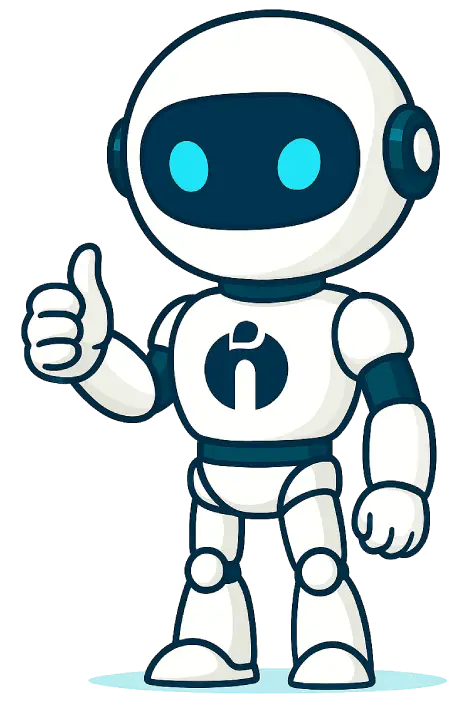





.webp)
.webp.dat)
